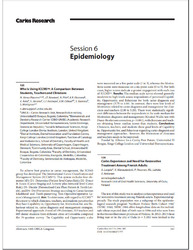Please use this identifier to cite or link to this item:
http://cris.unibe.edu.do/handle/123456789/64| Title: | Who is using ICCMS : A comparison between students, teachers, and clinicians [conference paper abstract] | Autores: | Abreu-Placeres, Ninoska Newton, J. T. Pitts, N. Ekstrand, K. R. Ávila, V. Jácome, S. Restrepo, L. F. Ochoa, E. M. Ramírez, S. Martignon, S. |
Researchers (UNIBE): | Abreu-Placeres, Ninoska | Affiliations: | Centro de Investigación en Biomateriales y Odontología (CIBO) | Research area: | Ciencias de la Salud | Issue Date: | 2017 | Source: | Caries Research, 51, 290-385 | Journal: | Caries Research | Series/Report no.: | Abstracts: 64th ORCA Congress. Session 6: Epidemiology, p. 147 | Volume: | 51 | Start page: | 290 | End page: | 385 | Conference: | 64th ORCA Congress. July 5-8, 2017, Oslo, Norway | Abstract: | To achieve best practice in caries management, the ICDAS group has developed The International Caries Classification and Management System (ICCMS). This system includes four elements (4D): D1- Determine (Patient-level Caries Risk); D2- Detect & Assess (Caries Staging and Activity plus Intraoral-level Caries Risk); D3- Decide (Personalised Care Plan: Patient & Tooth Levels), and D4- Do (Prevention Strategy according to Caries Lesions Likelihood and Tooth-preserving Non-Operative/operative Lesion’s Management). Aim: To determine, with regard to ICCMS the extent to which clinicians, teachers, and students perceive that they have Capability in, Opportunity for, Motivation for, and Behaviour related to, caries diagnosis and management strategies. Experimental approach: A total of 139 clinicians, 213 teachers and 605 dental students from different cities of Colombia completed the 79-question survey. The Capability and Opportunity scales were measured on a five-point scale (1 to 5), whereas the Motivations scores were measured on a six-point scale (0 to 5). For both cases, higher scores indicate a greater engagement with each area of ICCMS. Results: The median scale scores showed generally moderate to high levels across respondents of perceived Capability, Opportunity, and Behaviour for both caries diagnosis and management (3.75 to 4.88). In contrast, there were low levels of Motivation related to caries diagnosis and management for clinicians and teachers (2.00 to 3.20). There were statistically significant differences between the respondents in the scale medians for Motivation diagnosis and management (Kruskal-Wallis test with Dunn-Bonferroni correction, p < 0.001), with clinicians and teachers obtaining lower median scores than students. Conclusions: Clinicians, teachers, and students show good levels of Capability in, Opportunity for, and Behaviour regarding caries diagnosis and management approaches. However, the Motivation of clinicians and teachers needs to be improved. |
URI: | https://cris.unibe.edu.do/handle/123456789/64 | DOI: | 10.1159/000471777 |
| Appears in Collections: | Publicaciones del CIBO-UNIBE Publicaciones indexadas en Scopus / Web of Science |
Files in This Item:
| File | Description | Size | Format | |
|---|---|---|---|---|
| caries-research-51.pdf | Full text [open access] | 165.33 kB | Adobe PDF |  View/Open |
Items in DSpace are protected by copyright, with all rights reserved, unless otherwise indicated.
